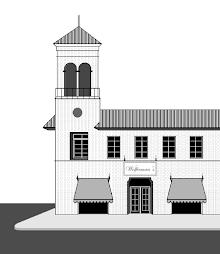
The number of company-owned (and not franchised) stores operated by America's large grocery chains, i.e., A & P, Kroger, Safeway and Grand Union, peaked in the late 1920s. In the 1930s, as the supermarket-type store came into its own, grocery chains were consolidating several smaller grocery stores into single supermarket operations. Hence, a particular chain's actual number of stores tended to drop during this time.
As America became increasingly auto-oriented during the 1920s and '30s, the car culture shopping center was born. Among the earliest was Kansas City's, Missouri's COUNTRY CLUB PLAZA. One of its first tenants was Wolferman's, a local gourmet grocery chain that opened On The Plaza in January 1924. Another early car culture retail complex, Columbus, Ohio's GRANDVIEW AVENUE SHOPPING CENTER, began business in 1928. It featured four grocery stores; A & P, Kroger, Piggly Wiggly and a local chain known as Polumbos.
At the close of World War II, the budding supermarket industry, whose development had been delayed by The Great Depression and a global conflict, was poised for major expansion. The auto-oriented shopping center, which had evolved in the 1920s and '30s, began to be built in suburban locations.


